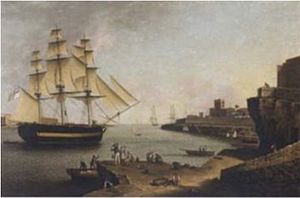HMS Europa (1783) facts for kids

Europa approaching Port Mahon, Minorca, by Anton Schranz
|
|
Quick facts for kids History |
|
|---|---|
| Name | HMS Europa |
| Ordered | 12 January 1778 |
| Builder | Woolwich Dockyard |
| Laid down | 26 September 1778 |
| Launched | 19 April 1783 |
| Completed | By 10 September 1783 |
| Honours and awards |
Naval General Service Medal with clasp "Egypt" |
| Fate | Sold for breaking up on 11 August 1814 |
| General characteristics | |
| Class and type | 50-gun Portland-class fourth rate |
| Tons burthen | 1,046 91⁄94 (bm) |
| Length |
|
| Beam | 40 ft 7+1⁄4 in (12.4 m) |
| Depth of hold | 17 ft 5+1⁄2 in (5.32 m) |
| Propulsion | Sails |
| Sail plan | Full-rigged ship |
| Complement | 350 |
| Armament |
|
HMS Europa was a 50-gun warship of the Royal Navy. It was built at Woolwich Dockyard in 1783. Europa was first based in Jamaica, an island in the Caribbean Sea. In 1785, the ship ran aground (got stuck) at Montego Bay, but it was not badly damaged. When news of the French Revolutionary Wars reached Jamaica, Europa joined other British ships to fight.
Contents
Europa's Journeys and Battles
In April 1793, the Royal Navy in Jamaica learned about a big war starting with France. The ships there, led by Commodore John Ford, got ready for action.
Fighting in the Caribbean
Europa helped by carrying soldiers and capturing French merchant ships. These French ships were often carrying important goods and supplies. On June 1, 1794, Europa worked with other British warships like HMS Belliqueux and HMS Sceptre. They attacked French forts to help capture Port-au-Prince, a city in Haiti.
Helping in Egypt
Later, in 1801, Europa was used to carry troops during a British mission to Egypt. The ship took part in a huge landing at Aboukir Bay. This attack helped the British defeat the French and capture the city of Cairo. Because Europa was part of this important mission in Egypt, its officers and crew received a special award. This award was a clasp (a small bar) that said "Egypt" for the Naval General Service Medal. This medal was given out in 1847 to all sailors who had served in that campaign.
What Happened to Europa?
In 1814, the British Navy decided to sell Europa. The ship was described as a "50-gun ship weighing 1047 tons." It was sold on August 11, 1814, in Portsmouth, England. The person who bought it had to promise to break the ship apart within a year. So, Europa was taken apart and no longer sailed.
Famous Sailors on Europa
Many important people in the Royal Navy served on HMS Europa. Here are a few:
- Joseph Whidbey - A Royal Navy officer who explored with the Vancouver Expedition. A famous island in Washington state, Whidbey Island, Washington, is named after him.
- George Vancouver - A well-known Royal Navy officer. He led a big expedition from 1791 to 1795 to explore the Pacific Coast of North America. Many places are named after him, like Vancouver Island, British Columbia.
- James Vashon - Another Royal Navy officer who served on the Vancouver Expedition. Vashon Island, Washington is named in his honor.
- Henry Digby - A senior Royal Navy officer. He famously saved the crew of HMS Boyne when it caught fire by accident.
- Peter Puget - A Royal Navy officer who explored the area now known as Puget Sound. This famous body of water in Washington state is named after him.
- Joseph Baker - A Royal Navy officer who was a mapmaker and surveyor on the Vancouver Expedition. Mount Baker is named after him.
- John Bligh - A Royal Navy officer who served during the American War of Independence and the Napoleonic Wars.
- John Cooke - A Royal Navy officer who fought in several wars, including the Battle of Trafalgar in 1805. He was killed in hand-to-hand combat during that battle.

